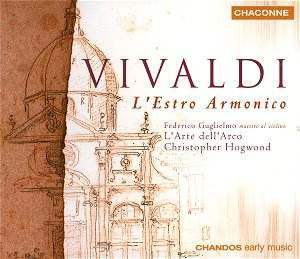|
The twelve l'estro armonico concertos, op. 3, are perhaps the
high point of this set. Scored for a small string orchestra (basically
an augmented string quartet - four violins, two violas, cello and double
bass - there are works featuring a solo violin, two violins and four violins)
and continuo, they are in the concerti grossi style, combining elements
of the Roman and Venetian styles prevalent in the early eighteenth century.
These concertos contain a wealth of musical variety, both in terms of
melody and in the way the different instruments combine. Their popularity
was immediate and widespread - the seminal influence of these works was
such that they laid the groundwork for the 18th century concerto. Composers
all across Europe came to know them. Even Bach, who made few such transcriptions
of other composers' works, transcribed five of them for solo harpsichord,
and one for four harpsichords and orchestra.
The works themselves are generally lively and expressive, with a variety
of melodic styles, ranging from the typically Vivaldian (the allegro
of the Concerto no. 2 in G minor), with repeated notes that recall the
Four Seasons, to the almost French-sounding allegro of Concerto no.
9 in D major. Vivaldi set out the ground rules for the concerto in the
set of works; it can be seen as a kind of guidebook to the concerto
form for future composers.
Christopher Hogwood's recording of these works breaks no new ground.
These performances are spirited and energetic, with the clean, crisp
sound and texture of authentic instruments. Comparing this set with
Trevor Pinnock's recordings on Archiv shows little difference, aside
from the pitch. Curiously, Hogwood records these concertos at A=440,
as opposed to a more "baroque" pitch.
Federico Gugliemo, the lead violinist, is an excellent performer. You
can hear how well he has mastered the Vivaldian idiom, especially in
the lively final movement of the 8th concerto. His interplay between
staccato strokes and legato passages gives a full range of colour to
these works. At times his violin sounds a bit harsh, and this will deter
those listeners who don't care for the 'green' sound of baroque violins
(his is a copy of a Guadagnini). But listening to his moving performance
of the solo section of the 9th concerto makes it all worthwhile.
This recording suffers from a slight lack of depth. At a time when
too many recordings have artificial reverberation added the light reverb
on this set seems to dull by comparison. Yet at higher volumes, the
sound comes alive and fills out the aural picture.
While this set is well performed, with a group of excellent musicians,
it lacks the energy that would set it apart from so many other Vivaldi
recordings. Perhaps after hearing Fabio Biondi's hyper-energetic interpretations
of Vivaldi, I find others bland? If you don't like Biondi's recordings,
though, you may appreciate this set more.
Kirk McElhearn
|
